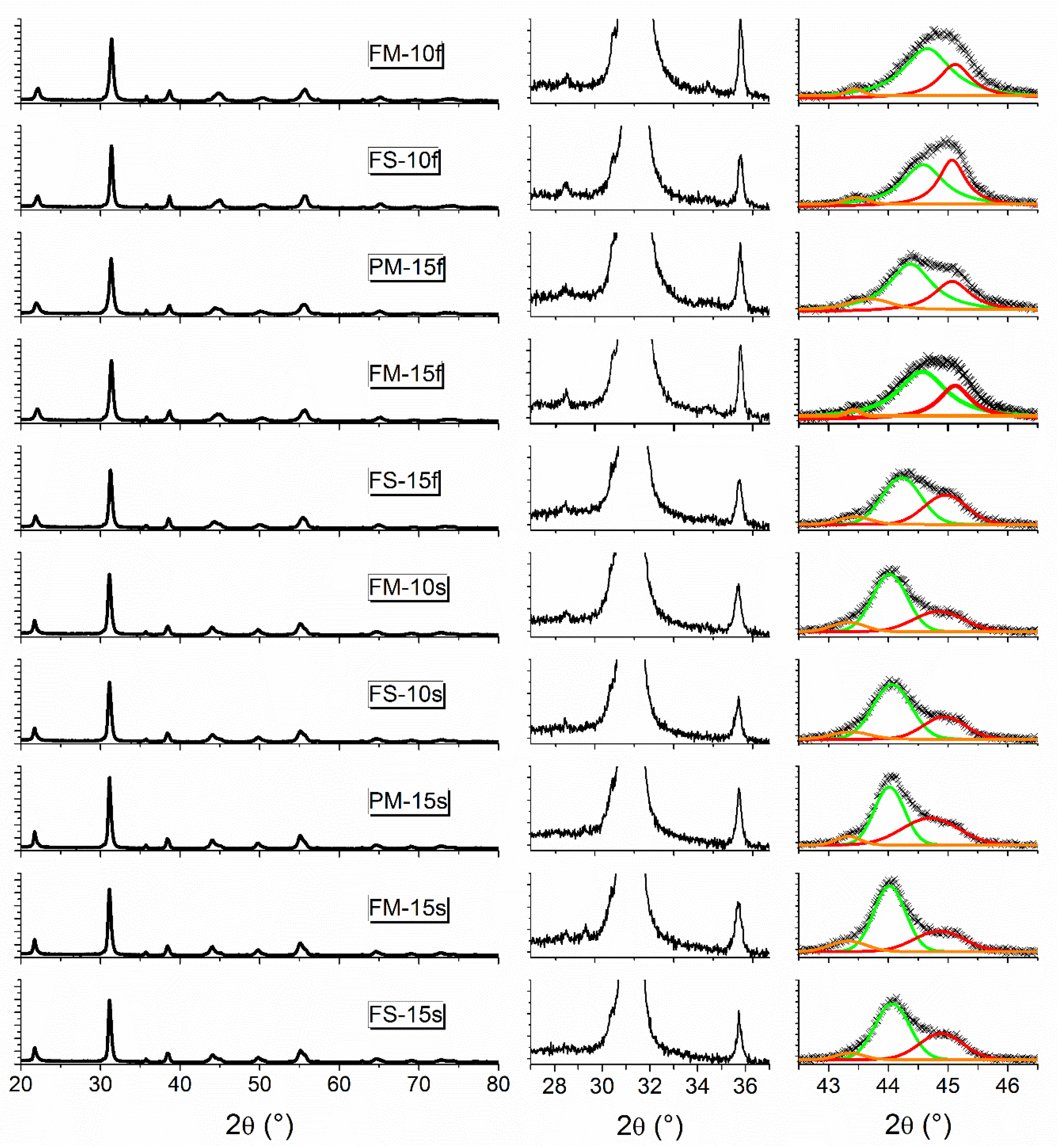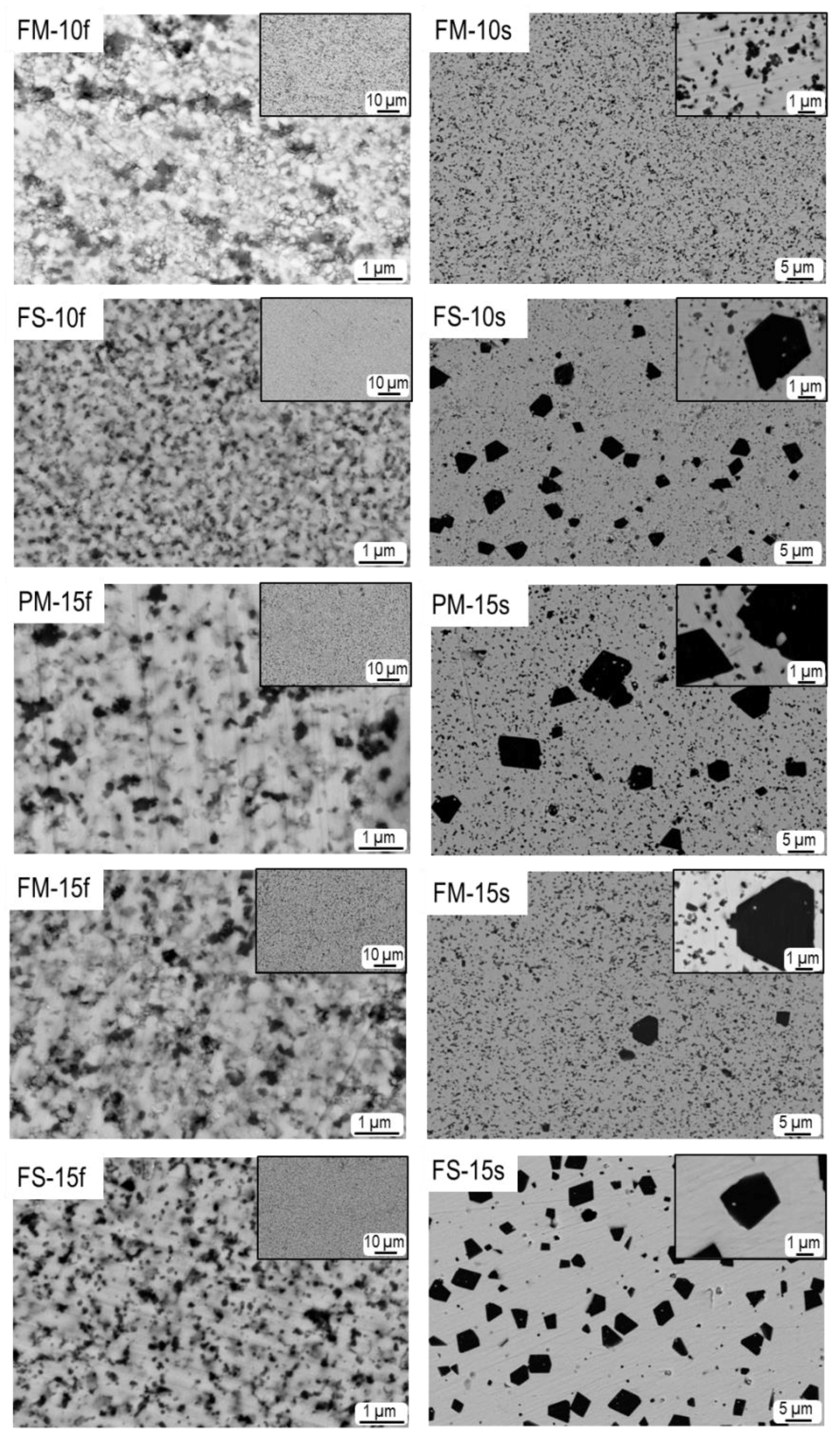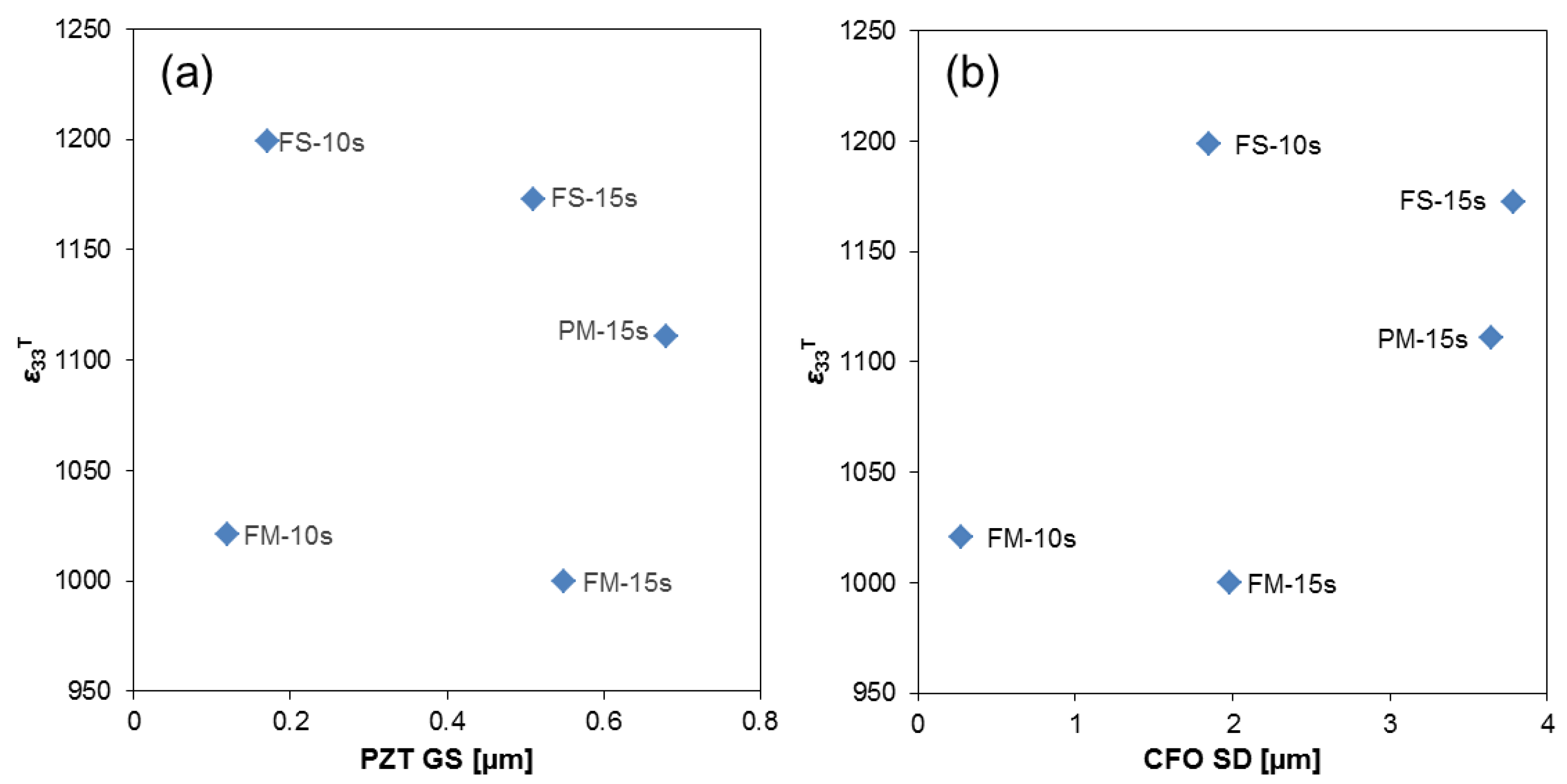A Glance at Processing-Microstructure-Property Relationships for Magnetoelectric Particulate PZT-CFO Composites
Abstract
1. Introduction
2. Materials and Methods
2.1. Sample Preparation
2.2. Microstructural Characterization
2.3. Electrical Characterization and Magnetoelectric Response
3. Results and Discussion
3.1. Microstructure
3.2. Dielectric, Piezoelectric and Mechanical Properties
3.2.1. Dielectric Permittivity and Loss Tangent
3.2.2. Piezoelectric Coefficients
3.2.3. Elastic Coefficients
3.3. Magnetoelectric Coefficients
4. Conclusions
Author Contributions
Funding
Acknowledgments
Conflicts of Interest
References
- Fang, K.Y.; Gong, L.H.; Jing, W.Q.; Fang, F. Nanoscale domain structure evolution and magnetoelectric coupling for PMN-33PT/Terfenol-D multiferroic composite. Mater. Today Commun. 2019, 21, 100650. [Google Scholar] [CrossRef]
- Vaz, C.A.F.; Hoffman, J.; Ahn, C.H.; Ramesh, R. Magnetoelectric coupling effects in multiferroic complex oxide composite structures. Adv. Mater. 2010, 22, 2900–2918. [Google Scholar] [CrossRef] [PubMed]
- Palneedi, H.; Annapureddy, V.; Priya, S.; Ryu, J. Status and perspectives of multiferroic magnetoelectric composite materials and applications. Actuators 2016, 5, 9. [Google Scholar] [CrossRef]
- Yan, Y.; Geng, L.D.; Tan, Y.; Ma, J.; Zhang, L.; Sanghadasa, M.; Ngo, K.; Ghosh, A.W.; Wang, Y.U.; Priya, S. Colossal tunability in high frequency magnetoelectric voltage tunable inductors. Nat. Commun. 2018, 9, 4998. [Google Scholar] [CrossRef] [PubMed]
- Vertsioti, G.; Zhang, S.J.; Stamopoulos, D. Pronounced and reversible modulation of the piezoelectric coefficients by a low magnetic field in a magnetoelectric PZT-5%Fe3O4 system. Sci. Rep. 2019, 9, 2178. [Google Scholar] [CrossRef]
- Wang, Y.; Li, M.; Hasanyan, D.; Gao, J.; Li, J.; Viehland, D. Geometry-induced magnetoelectric effect enhancement and noise floor reduction in Metglas/piezofiber sensors. Appl. Phys. Lett. 2012, 101, 022903. [Google Scholar] [CrossRef]
- Wang, Z.; Wang, X.; Li, M.; Gao, Y.; Hu, Z.; Nan, T.; Liang, X.; Chen, H.; Yang, J.; Cash, S.; et al. Highly Sensitive Flexible Magnetic Sensor Based on Anisotropic Magnetoresistance Effect. Adv. Mater. 2016, 28, 9370–9377. [Google Scholar] [CrossRef]
- Li, M.; Dong, C.; Zhou, H.; Wang, Z.; Wang, X.; Liang, X.; Lin, Y.; Sun, N.X. Highly Sensitive DC Magnetic Field Sensor Based on Nonlinear ME Effect. IEEE Sens. Lett. 2017, 1, 1–4. [Google Scholar] [CrossRef]
- Melzer, M.; Mönch, J.I.; Makarov, D.; Zabila, Y.; Bermúdez, G.S.C.; Karnaushenko, D.; Baunack, S.; Bahr, F.; Yan, C.; Kaltenbrunner, M.; et al. Wearable magnetic field sensors for flexible electronics. Adv. Mater. 2015, 27, 1274–1280. [Google Scholar] [CrossRef]
- Mintken, M.; Schweichel, M.; Schröder, S.; Kaps, S.; Carstensen, J.; Mishra, Y.K.; Strunskus, T.; Faupel, F.; Adelung, R. Nanogenerator and piezotronic inspired concepts for energy efficient magnetic field sensors. Nano Energy 2019, 56, 420–425. [Google Scholar] [CrossRef]
- Chakraborty, S.; Mandal, S.K. Magnetoelectric Zn0.2Co0.8Fe2O4-PbZr0.58Ti0.42O3 nanocomposite for bistable memory and magnetic field sensor applications. J. Magn. Magn. Mater. 2019, 491, 165573. [Google Scholar] [CrossRef]
- Hu, J.M.; Li, Z.; Chen, L.Q.; Nan, C.W. High-density magnetoresistive random access memory operating at ultralow voltage at room temperature. Nat. Commun. 2011, 2, 553. [Google Scholar] [CrossRef] [PubMed]
- Yang, F.; Zhou, Y.C.; Tang, M.H.; Liu, F.; Ma, Y.; Zheng, X.J.; Zhao, W.F.; Xu, H.Y.; Sun, Z.H. Eight-logic memory cell based on multiferroic junctions. J. Phys. D Appl. Phys. 2009, 42, 072004. [Google Scholar] [CrossRef]
- Wu, C.; Liu, Q.; Wang, Y.; Chen, J.; Qi, B.; Zhang, H.; Liu, Y. Room-temperature nonvolatile four-state memory based on multiferroic Sr3Co2Fe21.6O37.4. J. Alloys Compd. 2019, 115–120. [Google Scholar] [CrossRef]
- Lasheras, A.; Gutiérrez, J.; Reis, S.; Sousa, D.; Silva, M.; Martins, P.; Lanceros-Mendez, S.; Barandiarán, J.M.; Shishkin, D.A.; Potapov, A.P. Energy harvesting device based on a metallic glass/PVDF magnetoelectric laminated composite. Smart Mater. Struct. 2015, 24, 6. [Google Scholar] [CrossRef]
- Naifar, S.; Bradai, S.; Viehweger, C.; Kanoun, O. Survey of electromagnetic and magnetoelectric vibration energy harvesters for low frequency excitation. Measurement 2017, 106, 251–263. [Google Scholar] [CrossRef]
- Han, N.; Zhao, D.; Schluter, J.U.; Goh, E.S.; Zhao, H.; Jin, X. Performance evaluation of 3D printed miniature electromagnetic energy harvesters driven by air flow. Appl. Energy 2016, 178, 672–680. [Google Scholar] [CrossRef]
- Annapureddy, V.; Kim, M.; Palneedi, H.; Lee, H.Y.; Choi, S.Y.; Yoon, W.H.; Park, D.S.; Choi, J.J.; Hahn, B.D.; Ahn, C.W.; et al. Low-Loss Piezoelectric Single-Crystal Fibers for Enhanced Magnetic Energy Harvesting with Magnetoelectric Composite. Adv. Energy Mater. 2016, 6, 1601244. [Google Scholar] [CrossRef]
- Galizia, P.; Algueró, M.; Bernier, N.; Gambacorti, N.; Aza, E.; Lappas, A.; Venet, M.; Galassi, C. Magnetoelectric dual-particulate composites with wasp-waisted magnetic response for broadband energy harvesting. J. Alloys Compd. 2019, 783, 237–245. [Google Scholar] [CrossRef]
- Niu, L.; Shi, Y.; Gao, Y. Effect of magnetic-field orientation on dual-peak phenomenon of magnetoelectric coupling in Ni/PZT/Terfenol-D composites. AIP Advances 2019, 9, 045216. [Google Scholar] [CrossRef]
- Geiler, A.L.; Gillette, S.M.; Chen, Y.; Wang, J.; Chen, Z.; Yoon, S.D.; He, P.; Gao, J.; Vittoria, C.; Harris, V.G. Multiferroic heterostructure fringe field tuning of meander line microstrip ferrite phase shifter. Appl. Phys. Lett. 2010, 96, 053508. [Google Scholar] [CrossRef]
- Tatarenko, A.S.; Srinivasan, G.; Bichurin, M.I. Magnetoelectric microwave phase shifter. Appl. Phys. Lett. 2006, 88, 183507–183507-3. [Google Scholar] [CrossRef]
- Yang, X.; Gao, Y.; Wu, J.; Zhou, Z.; Beguhn, S.; Nan, T.; Sun, N.X. Voltage tunable multiferroic phase shifter with YIG/PMN-PT heterostructure. IEEE Microwave and Wireless Components Letters 2014, 24, 191–193. [Google Scholar] [CrossRef]
- Luo, Z.-D.; Apachitei, G.; Yang, M.-M.; Peters, J.J.P.; Sanchez, A.M.; Alexe, M. Bi-ferroic memristive properties of multiferroic tunnel junctions. Appl. Phys. Lett. 2018, 112, 102905. [Google Scholar] [CrossRef]
- Huang, W.; Fang, Y.-W.; Yin, Y.; Tian, B.; Zhao, W.; Hou, C.; Ma, C.; Li, Q.; Tsymbal, E.Y.; Duan, C.-G.; et al. Solid-state synapse based on magnetoelectrically coupled memristor. ACS Appl. Mater. Interfaces 2018, 10, 5649–5656. [Google Scholar] [CrossRef]
- Funsueb, N.; Ngamjarurojana, A.; Tunkasiri, T.; Limpichaipanit, A. Effect of composition and grain size on dielectric, ferroelectric and induced strain behavior of PLZT/ZrO2 composites. Ceram. Int. 2018, 44, 6343–6353. [Google Scholar] [CrossRef]
- Ai, D.; Xu, J.; Huang, C.; Zhou, W.; Zhao, L.; Sun, J.; Wang, Q. Synthesis and magnetoelectric properties of multiferroic composites of lead lanthanum zirconate titanate and mesoporous cobalt ferrite. Scr. Mater. 2017, 136, 29–32. [Google Scholar] [CrossRef]
- Galizia, P.; Ciomaga, C.E.; Mitoseriu, L.; Galassi, C. PZT-cobalt ferrite particulate composites: Densification and lead loss controlled by quite-fast sintering. J. Eur. Ceram. Soc. 2017, 37, 161–168. [Google Scholar] [CrossRef]
- Mandal, S.K.; Chakraborty, S.; Dey, P.; Saha, B.; Nath, T.K. Zn doped NiFe2O4- Pb (Zr0.58Ti0.42)O3 multiferroic nanocomposites: Magnetoelectric coupling, dielectric and electrical transport. J. Alloys Compd. 2018, 747, 834–845. [Google Scholar] [CrossRef]
- Bobić, J.D.; Ivanov, M.; Ilić, N.I.; Dzunuzović, A.S.; Petrović, M.M.V.; Banys, J.; Ribic, A.; Despotovic, Z.; Stojanovic, B.D. PZT-nickel ferrite and PZT-cobalt ferrite comparative study: Structural, dielectric, ferroelectric and magnetic properties of composite ceramics. Ceram. Int. 2018, 44, 6551–6557. [Google Scholar] [CrossRef]
- Zabotto, F.L.; Gualdi, A.J.; de Oliveira, A.J.A.; Eiras, J.A.; Garcia, D. Effect of different ferroelectric phases on magnetoelectric properties of Co-ferrite particulate composites. Ferroelectrics. 2016, 497, 92–99. [Google Scholar] [CrossRef]
- Sakanas, A.; Nuzhnyy, D.; Grigalaitis, R.; Banys, J.; Borodavka, F.; Kamba, S.; Ciomaga, C.E.; Mitoseriu, L. Dielectric and phonon spectroscopy of Nb-doped Pb(Zr1-yTiy)O3-CoFe2O4 composites. J. Appl. Phys. 2017, 121, 214101. [Google Scholar] [CrossRef]
- Zheng, Z.; Zhou, P.; Liu, Y.; Liang, K.; Tanguturi, R.G.; Chen, H.; Srinivasan, G.; Qi, Y.; Zhang, T. Strain effect on magnetoelectric coupling of epitaxial NFO/PZT heterostructure. J. Alloy Compd. 2020, 818, 152871. [Google Scholar] [CrossRef]
- Galizia, P.; Cernea, M.; Mihalache, V.; Diamandescu, L.; Maizza, G.; Galassi, C. Easy batch-scale production of cobalt ferrite nanopowders by two-step milling: Structural and magnetic characterization. Mater. Design 2017, 130, 327–335. [Google Scholar] [CrossRef]
- Dippong, T.; Cadar, O.; Levei, E.A.; Deac, I.G.; Borodi, G. Formation of CoFe2O4/PVA-SiO2 nanocomposites: Effect of diol chain length on the structure and magnetic properties. Ceram. Int. 2018, 44, 10478–10485. [Google Scholar] [CrossRef]
- Li, S.B.; Wang, C.B.; Shen, Q.; Hu, M.Z.; Zhang, L.M. Thickness ratio effect on multiferroic properties of BCZT-LCMO laminated composites prepared by Plasma Activated Sintering. J. Alloys Compd. 2018, 762, 415–421. [Google Scholar] [CrossRef]
- Schileo, G.; Pascual-Gonzalez, C.; Alguero, M.; Reaney, I.M.; Postolache, P.; Mitoseriu, L.; Reichmann, K.; Venet, M.; Feteira, A. Multiferroic and magnetoelectric properties of Pb0.99[Zr0.45Ti0.47(Ni1/3Sb2/3)0.08]O3–CoFe2O4 multilayer composites fabricated by tape casting. J. Eur. Ceram. Soc. 2018, 38, 1473–1478. [Google Scholar] [CrossRef]
- Ansaree, M.J.; Kumar, U.; Upadhyay, S. Structural, dielectric and magnetic properties of particulate composites of relaxor (BaTi0.85Sn0.15O3) and ferrite (NiFe2O4) synthesized by gel-combustion method. J. Electroceram. 2018, 40, 257–269. [Google Scholar] [CrossRef]
- Fernández, C.P.; Zabotto, F.L.; Garcia, D.; Kiminami, R.H.G.A. In situ sol–gel co-synthesis under controlled pH and microwave sintering of PZT/CoFe2O4 magnetoelectric composite ceramics. Ceram. Int. 2016, 42, 3239–3249. [Google Scholar] [CrossRef]
- Patel, B.; Zohdi, T.I. Numerical estimation of effective electromagnetic properties for design of particulate composites. Mater. Design 2016, 94, 546–553. [Google Scholar] [CrossRef]
- Dipti, D.; Singh, S.; Juneja, J.K.; Raina, K.K.; Pant, R.P.; Kotnala, R.K.; Prakash, C. Synthesis and characterization of PZT:CF magnetoelectric composites. Integr. Ferroelectr. 2016, 176, 109–117. [Google Scholar] [CrossRef]
- Miclea, C.; Tanasoiu, C.; Amarande, L.; Miclea, C.F.; Plavitu, C.; Cioangher, M.; Trupina, L.; Miclea, C.T.; Tanasoiu, T.; Susu, M.; et al. Magnetoelectric properties of multiferroic cobalt ferrite and soft piezoelectric PZT particulate composites. J. Optoelectron. Adv. M. 2010, 12, 272–276. [Google Scholar]
- Galizia, P.; Baldisserri, C.; Galassi, C. Microstructure development in novel titania-cobalt ferrite ceramic materials. Ceram. Int. 2016, 42, 2634–2641. [Google Scholar] [CrossRef]
- Randall, C.A.; Kim, N.; Kucera, J.-P.; Cao, W.; Shrout, T.R. Intrinsic and Extrinsic Size Effects in Fine-Grained Morphotropic-Phase-Boundary Lead Zirconate Titanate Ceramics. J. Am. Ceram. Soc. 2005, 81, 677–688. [Google Scholar] [CrossRef]
- Galassi, C.; Roncari, E.; Capiani, C.; Costa, A. Influence of Processing Parameters on the Properties of PZT Materials. In Piezoelectric Materials: Advances in Science, Technology and Applications, Proceedings of the NATO Advanced Research Workshop: Piezoelectric materials: advances in science, technology and applications, Predeal Romania, 23–27 May 1999; Galassi, C., Dinescu, M., Ukino, K., Sayer, M., Eds.; Kluwer Academics: Amsterdam, Netherlands, 2000; pp. 75–86. [Google Scholar]
- Galizia, P.; Baldisserri, C.; Capiani, C.; Galassi, C. Multiple parallel twinning overgrowth in nanostructured dense cobalt ferrite. Mater. Design 2016, 109, 19–26. [Google Scholar] [CrossRef]
- Jaffe, B.; Cook, W.R.; Jaffe, H. Piezoelectric Ceramics, 1st ed.; Academic Press: New York, NY, USA, 1971; pp. 135–183. [Google Scholar]
- Noheda, B.; Cox, D.E. Bridging phases at the morphotropic boundaries of lead-oxide solid solutions. Phase Transit. 2006, 79, 5–20. [Google Scholar] [CrossRef]
- Horchidan, N.; Ciomaga, C.E.; Frunza, R.C.; Capiani, C.; Galassi, C.; Mitoseriu, L. A comparative study of hard/soft PZT-based ceramic composites. Ceram. Int. 2016, 42, 9125–9132. [Google Scholar] [CrossRef]
- Cordero, F.; Trequattrini, F.; Craciun, F.; Galassi, C. Merging of the polar and tilt instability lines near the respective morphotropic phase boundaries of PbZr1−xTixO3. Phys. Rev. B 2013, 87, 094108. [Google Scholar] [CrossRef]
- Wang, S.; Xiao, X.; Deng, T.; Chen, A.; Zhu, M.A. Sauter mean diameter sensor for fire smoke detection. Sensor Actuat. B-Chem. 2019, 281, 920–932. [Google Scholar] [CrossRef]
- Kowalczuk, P.B.; Drzymala, J. Physical meaning of the Sauter mean diameter of spherical particulate matter. Particul. Sci. Technol. 2016, 34, 645–647. [Google Scholar] [CrossRef]
- Santa-Rosa, W.; Venet, M.; M’Peko, J.-C.; Moreno, R.; Amorín, H.; Algueró, M. Environmentally-friendly magnetoelectric ceramic multilayer composites by water-based tape casting. J. Eur. Ceram. Soc. 2019, 39, 1065–1072. [Google Scholar] [CrossRef]
- Mohaideen, K.K.; Joy, P.A. Enhancement in the Magnetostriction of Sintered Cobalt Ferrite by Making Self-Composites from Nanocrystalline and Bulk Powders. ACS Appl. Mater. Interfaces 2012, 4, 6421–6425. [Google Scholar] [CrossRef] [PubMed]









| Sintering | Sample | PZT Phase | CFO Phase | |||||||
|---|---|---|---|---|---|---|---|---|---|---|
| ID | ρ | P | aR | aT | cT | cT/aT | GS | GS | SD | |
| g/cm3 | vol% | Å | Å | Å | nm | nm | nm | |||
| Fast | FM-10f | 4.71 | 38 | 4.041 | 4.016 | 4.163 | 1.036 | 70 ± 10 | 73 | 83 |
| FS-10f | 4.98 | 35 | 4.079 | 4.025 | 4.161 | 1.034 | 60 ± 10 | 79 | 94 | |
| PM-15f | 5.84 | 23 | 4.088 | 4.035 | 4.163 | 1.032 | 100 ± 20 | 110 | 123 | |
| FM-15f | 5.43 | 29 | 4.046 | 4.011 | 4.165 | 1.038 | 70 ± 10 | 114 | 130 | |
| FS-15f | 6.93 | 9 | 4.093 | 4.029 | 4.163 | 1.033 | 70 ± 10 | 75 | 90 | |
| Slow | FM-10s | 7.59 | 0.4 | 4.111 | 4.039 | 4.173 | 1.033 | 120 ± 40 | 187 | 272 |
| FS-10s | 7.6 | 0.2 | 4.107 | 4.031 | 4.17 | 1.034 | 170 ± 40 | 543 | 1848 | |
| PM-15s | 7.62 | 0 | 4.111 | 4.051 | 4.173 | 1.030 | 680 ± 150 | 725 | 3640 | |
| FM-15s | 7.65 | 0 | 4.111 | 4.038 | 4.173 | 1.033 | 550 ± 140 | 366 | 1978 | |
| FS-15s | 7.58 | 0.5 | 4.107 | 4.036 | 4.17 | 1.033 | 510 ± 80 | 1791 | 3788 | |
| Sintering | ID | kp | −k31 | kt | −d31 | d33 | −g31 | g33 | e33T | e33S |
|---|---|---|---|---|---|---|---|---|---|---|
| (−) | (−) | (−) | (pm/V) | (pm/V) | (mV m/N) | (mV m/N) | (−) | (−) | ||
| Fast | FM-10f | 0.091 | 0.056 | 0.120 | 18 | 44 | 6.46 | 15.24 | 323 | 315 |
| FS-10f | 0.099 | 0.070 | 0.147 | 21 | 31 | 4.80 | 6.93 | 497 | 481 | |
| PM-15f | 0.094 | 0.055 | 0.117 | 19 | 35 | 3.13 | 5.80 | 672 | 657 | |
| FM-15f | 0.107 | 0.064 | 0.121 | 21 | 51 | 4.90 | 11.81 | 488 | 475 | |
| FS-15f | 0.123 | 0.066 | 0.176 | 25 | 63 | 3.05 | 7.58 | 939 | 896 | |
| Slow | FM-10s | 0.102 | 0.056 | 0.093 | 18 | 30 | 2.01 | 3.26 | 1021 | 1001 |
| FS-10s | 0.161 | 0.086 | 0.144 | 30 | 67 | 2.87 | 6.31 | 1199 | 1144 | |
| PM-15s | 0.114 | 0.062 | 0.089 | 21 | 40 | 2.10 | 4.07 | 1111 | 1088 | |
| FM-15s | 0.114 | 0.062 | 0.102 | 20 | 45 | 2.23 | 5.03 | 1000 | 976 | |
| FS-15s | 0.229 | 0.121 | 0.113 | 44 | 96 | 4.21 | 9.25 | 1173 | 1097 |
| Sintering | ID | Np | Nt | c33E | c33D | s11E | -s12E | Qm | σE | v1E | Z |
|---|---|---|---|---|---|---|---|---|---|---|---|
| (m/s) | (m/s) | (1010 N/m2) | (1010 N/m2) | (10−12 m2/N) | (10−12 m2/N) | (-) | (-) | (m/s) | (106 kg/(m2s)) | ||
| Fast | FM-10f | 1558 | 1260 | 3.0 | 3.0 | 38.5 | 9.6 | 128 | 0.2498 | 2349 | 11.1 |
| FS-10f | 1716 | 1516 | 5.1 | 5.2 | 21.0 | 0.3 | 99 | 0.0115 | 2915 | 16.4 | |
| PM-15f | 2060 | 1672 | 6.5 | 6.6 | 19.2 | 6.0 | 132 | 0.3122 | 2990 | 17.4 | |
| FM-15f | 1827 | 1533 | 5.1 | 5.2 | 25.1 | 6.9 | 112 | 0,2765 | 2711 | 14.7 | |
| FS-15f | 2113 | 1925 | 10.2 | 10.5 | 19.3 | −9.0 | 104 | 0.4666 | 2735 | 18.9 | |
| Slow | FM-10s | 2485 | 2228 | 15.5 | 15.6 | 11.8 | 4.8 | 145 | 0.4059 | 3377 | 25.0 |
| FS-10s | 2507 | 2262 | 15.3 | 15.6 | 11.9 | 5.1 | 196 | 0,4309 | 3341 | 25.1 | |
| PM-15s | 2506 | 2287 | 15.9 | 16.0 | 11.4 | 4.7 | 171 | 0.4108 | 3393 | 25.8 | |
| FM-15s | 2490 | 2178 | 14.4 | 14.5 | 11.7 | 4.8 | 245 | 0.4146 | 3362 | 25.5 | |
| FS-15s | 2490 | 2300 | 15.5 | 15.7 | 12.6 | 5.6 | 1237 | 0.4423 | 3288 | 24.1 |
© 2020 by the authors. Licensee MDPI, Basel, Switzerland. This article is an open access article distributed under the terms and conditions of the Creative Commons Attribution (CC BY) license (http://creativecommons.org/licenses/by/4.0/).
Share and Cite
Galizia, P.; Baldisserri, C.; Mercadelli, E.; Capiani, C.; Galassi, C.; Algueró, M. A Glance at Processing-Microstructure-Property Relationships for Magnetoelectric Particulate PZT-CFO Composites. Materials 2020, 13, 2592. https://doi.org/10.3390/ma13112592
Galizia P, Baldisserri C, Mercadelli E, Capiani C, Galassi C, Algueró M. A Glance at Processing-Microstructure-Property Relationships for Magnetoelectric Particulate PZT-CFO Composites. Materials. 2020; 13(11):2592. https://doi.org/10.3390/ma13112592
Chicago/Turabian StyleGalizia, Pietro, Carlo Baldisserri, Elisa Mercadelli, Claudio Capiani, Carmen Galassi, and Miguel Algueró. 2020. "A Glance at Processing-Microstructure-Property Relationships for Magnetoelectric Particulate PZT-CFO Composites" Materials 13, no. 11: 2592. https://doi.org/10.3390/ma13112592
APA StyleGalizia, P., Baldisserri, C., Mercadelli, E., Capiani, C., Galassi, C., & Algueró, M. (2020). A Glance at Processing-Microstructure-Property Relationships for Magnetoelectric Particulate PZT-CFO Composites. Materials, 13(11), 2592. https://doi.org/10.3390/ma13112592






